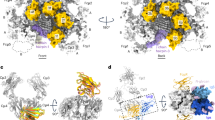Abstract
Antibodies of the immunoglobulin E isotype sensitize mast cells and basophils for antigen-induced mediator release by binding through the Fc portion to a high-affinity receptor (FcɛRl, Ka = 109 M−1) on the cell surface1,2 causing the clinical manifestations of type I hypersensitivity. As the amino acid sequence of the human epsilon chain is now known3, attempts have been made to map the FcɛRl binding site on IgE to a fragment smaller than Fcɛ using proteolytic cleavage products, none of which proved to be active3. Cleavage between the Cɛ2 and Cɛ3 domains released two inactive fragments, suggesting that the junction between these segments could be important in receptor binding3. This region is protected against protease digestion in the rat IgE complex with the receptor of rat basophilic leukaemia cells4. Here we report the mapping of the mast cell receptor binding site on human IgE to a sequence of 76 amino acids at the Cɛ2/Cɛ 3 junction. Recombinant peptides containing this sequence inhibit passive sensitization of skin mast cells in vivo and sensitize mast cells to degranulation by anti-IgE in vitro almost as efficiently as a myeloma IgE. Fragments containing the separate domains are inactive. Additional sequences are required for rapid assembly of fragments into disulphide-linked dimers, suggesting that a single chain can form the active site. In a three-dimensional model of the human Fcɛ, the two identical segments are far apart. Each folds to generate a cleft between the Cɛ2 and Cɛ3 domains on the surface of the Fcɛ. The docking of IgE on to mast cells could take place within this cleft.
This is a preview of subscription content, access via your institution
Access options
Subscribe to this journal
Receive 51 print issues and online access
$199.00 per year
only $3.90 per issue
Buy this article
- Purchase on Springer Link
- Instant access to full article PDF
Prices may be subject to local taxes which are calculated during checkout
Similar content being viewed by others
References
Stanworth, D. R., Humphrey, J. H., Bennich, H., Johannson, S. G. O. Lancet 2, 17–18 (1968).
Ishizaka, K., Ishizaka, T. & Lee, E. H. Immunochemistry 7, 687–702 (1970).
Dorrington, K. J. & Bennich, H. Immun. Rev. 41, 3–25 (1978).
Perez-Montfort, R. & Metzger, H. Molec. Immun. 19, 1113–1125 (1982).
Kenten, J. H., Helm, B. A., Ishizaka, T., Cattini, P. & Gould, H. Proc. natn. Acad. Sci. U.S.A. 81, 2955–2959 (1984).
Liu, F.-T., Albrandt, K. A., Bry, C. G. & Ishizaka, T. Proc. natn. Acad. Sci. U.S.A. 81, 5369–5373 (1984).
Coleman, J. W., Helm, B. A., Stanworth, D. R. & Gould, H. J. Eur. J. Immun. 15, 966–969 (1985).
Geha, R. S., Helm, B. & Gould, H. Nature 315, 577–578 (1985).
Ishizaka, T. et al. Proc. natn. Acad. Sci. U.S.A. 83, 8323–8327 (1986).
Padlan, E. A. & Davies, D. R. Molec. Immun. 23, 1063–1075 (1986).
Fergusen, K. A. Metabolism 13, 982–1002 (1964).
Prausnitz, C. & Kustner, H. Zbl. Bkt. Orig. 86, 166–169 (1921).
Stanworth, D. R., Kings, M., Roy, P. D., Moran, J. M. & Moran, D. M. Biochem. J. 180, 665–668 (1979).
Burt, U. S. & Stanworth, D. R., Eur. J. Immun. 17, 437–440 (1987).
Prenner, B. M. Annls Allergy 55, 332–335 (1987).
Ashihari, Y., Arata, Y. & Hamaguchi, K. J. Biochem, Tokyo 97, 517–528 (1985).
Pumphrey, R. Immun. Today 7, 174–178 (1986).
Deisenhofer, J. Biochemistry 20, 2361–2370 (1981).
Holowka, D., Conrad, D. H. & Baird, B. Biochemistry 24, 6260–6267 (1985).
Baenziger, J. V. in Immediate Hypersensitivity, Modern Concepts and Developments (ed. Bach, M. K.) 37–46 (Dekker, N.Y., 1978).
Kronvall, G. & Frommel, D. Immunochemistry 7, 124–127 (1970).
Metzger, H. et al. A. Rev. Immun. 4, 419–470 (1986).
Peterson, G. L. & Dorrington, K. J. J. biol. Chem. 249, 5633–5641 (1974).
Laemmli, U. K. Nature 227, 680–685 (1971).
Author information
Authors and Affiliations
Rights and permissions
About this article
Cite this article
Helm, B., Marsh, P., Vercelli, D. et al. The mast cell binding site on human immunoglobulin E. Nature 331, 180–183 (1988). https://doi.org/10.1038/331180a0
Received:
Accepted:
Published:
Issue Date:
DOI: https://doi.org/10.1038/331180a0
This article is cited by
-
Immunoglobulin Glycosylation Effects in Allergy and Immunity
Current Allergy and Asthma Reports (2016)
-
Potential effector and immunoregulatory functions of mast cells in mucosal immunity
Mucosal Immunology (2015)
-
A novel human immunoglobulin Fcγ–Fcɛ bifunctional fusion protein inhibits FcɛRI-mediated degranulation
Nature Medicine (2002)
Comments
By submitting a comment you agree to abide by our Terms and Community Guidelines. If you find something abusive or that does not comply with our terms or guidelines please flag it as inappropriate.



